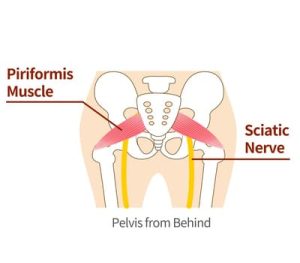A Pain in the Butt
Piriformis Syndrome
 We’re all familiar with emotional pain in the butts, but what is going on when we actually experience a physical pain in the butt? Pain in the buttocks can mean you have Piriformis Syndrome.
We’re all familiar with emotional pain in the butts, but what is going on when we actually experience a physical pain in the butt? Pain in the buttocks can mean you have Piriformis Syndrome.
The piriformis muscle is located in the buttocks near the top of the hip joint. It keeps the hip joint stable and lifts and rotates the thigh away from the body, making it possible for you to walk, shift your weight from one foot to another, and maintain balance.
Piriformis Syndrome is when the piriformis muscle compresses the sciatic nerve. The sciatic nerve goes alongside or through the piriformis muscle, then down the back of the leg, before going into the smaller nerves that end in the feet. Sciatica nerve compression can be caused by spasm of the piriformis muscle
It is estimated that about ten percent of the three million cases of sciatica reported each year are related to the piriformis.
Causes
There a number of reasons you might have acquired Piriformis Syndrome, including:
- A spasm in the piriformis muscle, caused by irritation in the muscle itself, or irritation of the sacroiliac joint or hip
- The tightening of the muscle, because of an injury or spasm
- Swelling of the piriformis muscle, because of injury or spasm
Other spine and hip issues can also be the cause of pain in the buttocks. You may have a herniated disc, your sacroiliac joint could have become inflamed, or it is possible for sciatica to occur when parts of the spine narrow and put pressure on the sciatic nerve.
It’s wise, especially if there is no obvious cause for your pain, and it persists or gets worse, to make an appointment to see your physician.
Symptoms
You may have Piriformis Syndrome if you are either experiencing pain in the buttocks and/or pain that is spreading into the back of the leg. This type of pain can also move down into your feet. Other common symptoms include the feeling of pins and needles, with tingling in the hip, buttocks or thigh, a kind of dull ache in the buttocks, and/or the loss of range of motion of the hip.
Treatment
Most often, treatment for this problem starts with stretching exercises and massage, as well as rest, ice and heat treatments. There are also times when anti-inflammatory drugs may be prescribed.
Your doctor of physical therapist may also recommend that you stop running, bicycling, or doing other more strenuous physical activities. A corticosteroid shot near where the piriformis muscle and the sciatic nerve meet can sometimes give you temporary relief. In some cases, surgery is recommended.
The Cleveland Clinic’s website offers the “Best Stretches and Exercises for Piriformis Syndrome.” To watch videos of these stretches, go to:
https://health.clevelandclinic.org/piriformis-syndrome-stretches-exercises/
